Cycling
Cycling
Cycling allows you to see places close up and at a slower pace. It keeps you aware of your surroundings and you get to experience a place more intimately than you would as a bus or taxi passenger. You'll see more of street life and meet people going about their daily business. It is also a great way to return from your holidays fitter and healthier than when you left, and puts less burden on the environment.
Understand
The bicycle can be used as a vehicle for transportation, as well as a piece of sport equipment.
For tourists and adventurers, there are definitely better and worse places to cycle, but there's not many places you can't reach by bike. The good news is that cycling is becoming easier in many western countries for both getting around town or for long distance touring. In Europe, Canada and America, money is being invested in converting old railways, building dedicated cycleways and putting in cycle lanes on busy roads. In Asia and Africa, the pattern is very different. In China, Vietnam and India, the bicycle was often the dominant mode of transport. Here, cycling is in decline, and has been thought of as a sign of past poverty. There are some signs of a return to bike transport in these countries, because of congestion and health benefits, particularly in China. Even in India, cycling is beginning to benefit as it is taken up by parts of the middle classes. Somewhat surprisingly, the bicycle has long been marginalized in Africa, despite being a cheap way to provide local mobility.
Urban cycling
Main article: Urban cycling
Cities offer many opportunities for cycle tourism, especially in places that provide for it. In some cities cycling is the preferred method of locals to commute, run their errands and get to leisure activities. Some cities have designated bicycle paths, and even bike sharing programs for short-term bike rental (minutes or hours) as well as rental for hours or days in shops. See Bike rental below.
Tour cycling
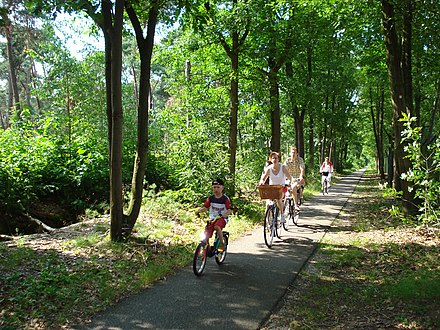
%2C_cyclotourisme.JPG/440px-Eerde_(N-Br,_NL),_cyclotourisme.JPG)
Tour cycling is cycling as a means of transportation over long distances, over one or several days. Touring is quite a popular kind of adventure holiday, and you can find many blogs detailing people's experiences, cycling independently in places you really wouldn't expect.
Correctly packed bikes can be taken on most trains, ferries and planes, and even sometimes on buses. In some countries a bike can often be taken aboard as is.
You can tour by yourself, or you can go with a commercial guided tour. These have the advantage of making all the logistical and accommodation arrangements, and usually bringing your luggage along in a van, but can be very pricey.
Mountain biking
Main article: Mountain biking
Hilly, less accessible places make exhilarating riding, but you will want a bike built for it. If you are going off public roads, check the relevant legislation (e.g. in England biking is allowed along public bridleways, but not along public footpaths).
Sport cycling
Cycling can also be pursued as an amateur sport. There are open annual events around the world, such as Vätternrundan, part of the Swedish Classic Circuit.
Cycling is also pursued as a professional sport, with the pinnacle of the sport being the Three Grand Tours namely the Vuelta a España, the Giro d'Italia and the most prestigious of them all, the Tour de France, all of which are broadcast on television. Cycling is also contested at the Olympics, where it is divided into four disciplines: road cycling, track cycling, mountain biking and BMX.
Get in
In some cases a traveler may be able to bring a bicycle from home; usually the handlebars and pedals need to be turned or removed to fit the bicycle into a "bike box" for transport on intercity bus or rail. Airlines may or may not accommodate bikes; exact policies vary and change so much that you should rather check with your airline directly.
The bicycle

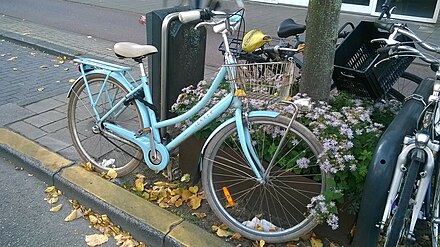 There are several bicycle models. Those which are most commonly used for personal transportation are:
There are several bicycle models. Those which are most commonly used for personal transportation are:
- A utility bicycle is a traditional bicycle model suitable for urban cycling. It usually ships with a bell, a stand, a rack, and other equipment absent on racers and mountain bikes. It has a simple gear system or no gears at all.
- A racing bicycle is made for road cycling, usually with narrow tires inflated to a high pressure, which gets uncomfortable with even slight bumps in the road. Often built for light weight above everything.
- A mountain bike is made for offroad cycling. If they are fitted with lights, a bell and other safety equipment, they are useful for urban cycling as well.
- A cargo bike has a cargo hold in the front, which can also be used for a passenger.
- An electric bicycle has a supportive electric motor. They may or may not be legal on bike trails depending on local laws and the speed at which the electric assistance switches off.
- An electric kickbike can be available in some bikeshare schemes, and a very casual option for urban cycling.
- A personal transporter is an electric personal vehicle, including brands such as Segway and Hoverboard. In many jurisdictions, they are classified as bicycles.
- A beach cruiser has very wide tires and is best adapted to loose soils and lower speeds. Some bikeshare bikes fall under this category.
- A fat bike has even wider tires, for loose soil.
 A rickshaw is used to carry one or a few passengers, usually as a taxi service.
A rickshaw is used to carry one or a few passengers, usually as a taxi service.- A folding bicycle can be folded to fit into a small space.
There is also often a difference made between "men's bikes" and "women's bikes". The main difference is in the frame, which is better adapted to riding with a skirt in the case of women's bicycles. Sometimes they may also have slightly different saddles, but if you plan to spend much time in the saddle, you should get one fit individually for you.
Bike rental
See also: Urban cycling#Bike sharing programs

Instead of bringing your own bike, you can rent a bike in most towns, for a few hours, a day or longer. Price per hour usually goes down quickly as rental time increases. Places to ask include bike shops, tourist businesses and tourist information points. Think beforehand about what type of bike and what equipment you need. Some firms charge extra for racks, headlights and locks even when such are more or less necessary. Some equipment you find necessary may not be easily available.
There are two fundamentally different brake systems: hand brakes and foot brakes. The former are used on nearly all sport bikes, while the latter are the ones used on robust gearless bikes. Three-gear bikes (for everyday use) also have foot brakes, often complemented with a hand brake for the front wheel. If you are used only to one system, be careful if you rent one with the other, at least until you have got your reflexes working.
Similarly there are internal gears (on three-gear bikes) and external gears. Changing gear requires slightly different techniques (stopping your feet for a moment or moving them gently while the gear changes).
Sometimes it is cheaper to buy a used bike locally than to bring your own or rent. These may be available, e.g. at thrift shops, pawn shops, and garage sales. Many cities also have semi-regular auctions of bikes abandoned on the street, which can be good deals, but are often frequented by professional resellers who drive prices. Check the condition, as fixing any fault can be inconvenient and time consuming when you do not have the needed tools, and new spares can easily cost as much as the bike itself.
In some cases buying a new bike can be an option, if you know you will find what you are looking for and are going on a longer tour. Bikes do drastically use value from "new" to "used" even after only a couple hundred kilometers or a few months of use, so trying to sell a used bike will almost always net you a significant loss over your initial purchase price; do not base you budget on recouping most of the investment in a new bike.
Maps and routes
Cycling information and routes are usually found online, often from local authorities websites. OpenStreetMap, has user compiled cycling routes available rendered as a layer on its main website, and cycling routing maps available to download to Garmin devices that you can mount on your bike. There are many apps that can be downloaded to smartphones that take advantage of OSM data.
Google and Apple Maps also have cycle route layers for many places and Android phones already include it.
Cycling organizations
Similar to motorists, cyclists have formed associations for mutual assistance as well as political lobbying soon after the invention of modern cycling. Some organizations in fact date back to before the first motorist associations. Besides political advocacy, they usually offer roadside assistance, maps for cycling trips, lists of "bike-friendly" accommodation, discounts with their partners and a newsletter. Other minor benefits may be included as well. The biggest associations usually exist in countries with a healthy cycling tradition and most European cycling clubs cooperate in the European Cyclist Federation. In the USA the League of American Bicyclists that was founded (under a different name) in 1880 is the major nationwide cycling organization.
Many cyclist organizations evaluate the "bicycle-friendliness" of cities in regular intervals. Cities are judged along criteria such as public policy, availability of facilities, the general attitude towards cycling and other factors. As these reports are intended to shape public policy they are usually available for free in their entirety. They are a good resource to determine where cycling is a breeze and where it is a challenge.
Destinations
You can bike anywhere, but there are places where cycling is particularly good or easy. These are some of the more popular destinations and cycle routes, to give you a taste of what's possible.
Africa
See also: Cycling the Western Sahara
Cycling in Africa has declined, and is below western levels in most countries. This seems to be in part because of poor infrastructure design in most cities and a perception of cycling as dangerous or as associated with poverty. Cape Town has a few cycle paths and lanes, but it is an exception even in South Africa.
Cycling the length of the African continent is one of the great touring challenges. Heat, disease, wild animals, poor roads, bike maintenance and logistical challenges stack up against experiencing the extraordinary landscapes and peoples.
In Madagascar cycling is still a good way to explore the country, but be wary of poor infrastructure.
Asia
China

China still has a high proportion of cyclists, although traffic can be dangerous. Cities like Beijing, Shanghai or Suzhou continue to have very good cycle infrastructure, even if car traffic is much more dominant than it once was. There is a 70 km segregated cycle lane between Shanghai and Suzhou. Hong Kong has less cycling than the mainland, but is beginning to become more bike-friendly, with a network of dedicated cycle paths around the New Territories.
The Yunnan-Tibet Highway has become a particularly popular challenge for touring cyclists. The end part of route isn't easily navigable for foreigners, however, because of restrictions on entry to Tibet. See also Yunnan tourist trail and Overland to Tibet.
The Karakoram Highway leading south from western China to Pakistan is a popular, though very challenging, cycle route.
Japan
Japan can be a good place for cycling. Drivers are more polite than almost anywhere else and cycling is quite common in some cities, like Kyoto.
An excellent series of maps are called "Touring Mapple". They are produced for Japanese motorcycle tourists, but have a great deal of useful information for bicycle tourists. They list scenic routes, campgrounds, hostels, and numerous minor roads. As they are Japanese language they are of limited use for general navigation for those without some Japanese reading skills, however they can be quite useful when supplemented with an English (or romaji) map. Translations of the index are available online.
Bikes are required to be registered at a police station, though this is unlikely to be enforced if you are touring. Officially, cycling on pavements is outlawed, but this seems to be generally overlooked; in any case many pavements are officially dual use. Children, by law, must wear helmets.
A well known route is the Shimanami Kaido Bikeway, that connects the main island of Honshu to Shikoku, and runs from Onomichi City to Imabari City, a distance of 70 km. Some other popular routes are the Kibi Plains Cycling Route from Okayama to Soja, Hamanako Cycling Course around the lake in Hamamatsu, and the nations' longest cycling course, the Tonegawa Cycling Road, stretches from Gunma Prefecture through Saitama Prefecture all the way to the Pacific Ocean, totaling 170km.
Nearly every large city and many small cities have Rentacycle options, usually for a single day at a time but longer rental options are sometimes available. In areas with well-known and popular cycling routes, there are certain to be places to rent bicycles, so it is not necessary to bring a bike to Japan unless you are planning more original routes or traveling across country. Some places, like the aforementioned Shimanami Kaido and Kibi Plains Cycling Route allow you to rent a bike at one end and return it at the other end.
Taiwan
Cycling in Taiwan is improving, with new cycle paths, but driving standards are quite poor. Kaohsiung has 150 km of cycle lanes and a city bike hire scheme.
Thailand
The Samoeng Loop is a 100 km ride that departs Chiang Mai, heads into the mountains to the west, and loops back to the city. Popular with bicyclists and motorcycle aficionados alike.
United Arab Emirates
One of only three countries in the world which mandates bicycle helmet wearing for all ages (the others being Australia and New Zealand) and, of course, it can be hellishly hot. Fuel and air conditioned vehicles are as cheap here as anywhere in the world and both recreational and commuter cycling is paltry.
Vietnam
Most people still use bicycles in Vietnam, so cycling there can be a good choice. However motorised traffic is rapidly coming to dominate Vietnam's roads, especially near Saigon, meaning it is no longer the cycling paradise it perhaps once was.
National Highway 1 is a well-known route for long cycle tours, being Vietnam's main north-south road. There are plans to upgrade it to a six lane highway however, so it may not be a great route for much longer. The southern 1,100 km tends to be more popular, as it is reputedly more scenic and include long stretches of beach.
A popular alternative is to choose parts of the Ho Chi Minh Trail, which was the network of supply routes used by the Communist north to supply their troops in the south during the Vietnam War. This takes in the rural areas, crosses into Laos, and is much tougher cycling.
Pakistan
Cycling in Pakistan is very common. Cyclists often cycle the Karakoram Highway through the Hunza Valley in Pakistan to China. The Khunjerab Pass, at 4863 m, is the highest paved international border crossing in the world and the highest point on the Karakoram Highway. Organised tours and books about the journey are available.
India
Cycling in India is very common, and is becoming more popular as a leisure activity. There a number of informally known routes that are popular, but few that are officially designated. A few areas and routes worth mentioning would include:
- Manali to Leh - around 500 km through parts of the Himalayas
- Gujarat
- Sikkim
- Alibag coastal, flat, prone to wind
- Pune to Panshet Dam taking in Sinhagarh Fort
- Kerala
- Bangalore
Australasia and Oceania
Australia
See also: Cycling in New South Wales
Australia is making efforts to improve cycling, and cities like Brisbane have better routes and city hire schemes. Australia was the first country in the world to impose uniform national mandatory bicycle helmet legislation, beginning in 1990 and it is illegal to ride without a helmet (except that in the Northern Territory there is an exemption for adults cycling along footpaths or on cycle paths).
Former railway lines in all states of Australia have been developed into rail trails. There is rail trail information available for the following regions of Australia:
Victoria is a particularly good state to explore by bike, with a variety of scenery, many rail trails and a good public transport network.
New Zealand
Cycling is not a major commuter activity in New Zealand (except in Nelson), although it is increasingly popular as a sport and leisure activity and mountain biking is particularly well developed in Nelson.
Beware of buses and trucks on main roads as many drivers will not give you sufficient overtaking clearance; proportionately, five times as many cyclists are injured and killed on New Zealand roads as in the Netherlands or Singapore! You should also be prepared for the large distances between towns and cities and the generally windy weather. While there are some areas of New Zealand that are flat, most tourists cycling in New Zealand will find that they need to be able to cope with long hill climbs and variable weather conditions.
A network of cycleways is being built around New Zealand, with some safe and beautiful routes already constructed: NZ Cycleways. Helmets must be worn by law.
Europe
Main article: Cycling in Europe
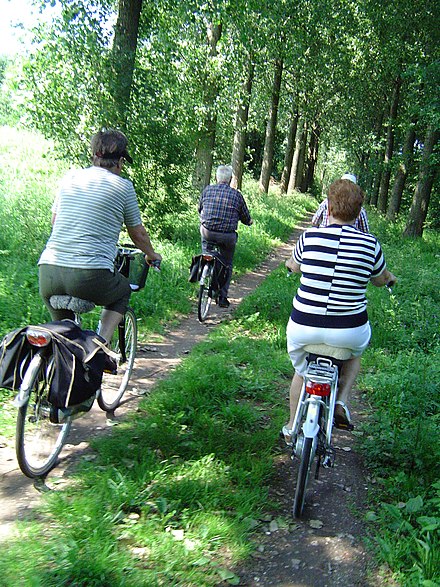
 Most Western and Central European countries have well-developed tourist routes, in addition to commuter cycling in cities. Netherlands and Denmark are especially well-known for their bicycle infrastructure. In France, cycling is a national sport, although cycling in most cities is not as good as in northern Europe. Bike-share schemes have become increasingly common in European cities. See the "get around" sections of the corresponding city articles for more detail on that.
Most Western and Central European countries have well-developed tourist routes, in addition to commuter cycling in cities. Netherlands and Denmark are especially well-known for their bicycle infrastructure. In France, cycling is a national sport, although cycling in most cities is not as good as in northern Europe. Bike-share schemes have become increasingly common in European cities. See the "get around" sections of the corresponding city articles for more detail on that.
- Cycling in the Netherlands
- Cycling in Denmark
- Cycling in Germany
- Cycling in Sweden
- Cycling in Switzerland
- Cycling in England and Wales
- Cycling in Scotland
Middle East
Beirut
Beirut's downtown has a car-free Sunday.
Jordan
Petra & Wadi Rum
North America
Canada
Ottawa, Vancouver and Montreal have good and developing systems of local bike routes. Edmonton in the Prairies and Victoria in the West are said to be among the most bike-friendly in the country.
Touring in Canada
The following are Canadian cycling routes:
- The Trans Canada Trail is a set of linking trails connecting east, west and north Canada.
- The Route Verte has 4,600 km (3,059 mi) of tracks in Quebec, including leisure and commuter routes. It is claimed to be the most extensive network in North America.
USA
Main article: Cycling in the United States
 Although car culture is strong in the United States, cycling does exist in the country. Cycling is especially popular in Portland and Minneapolis, and other cities such as Los Angeles, Chicago, Seattle, Boston, and Fort Collins have decent cycling options. There are also several long bicycle trails in the United States which are all at least a thousand miles long.
Although car culture is strong in the United States, cycling does exist in the country. Cycling is especially popular in Portland and Minneapolis, and other cities such as Los Angeles, Chicago, Seattle, Boston, and Fort Collins have decent cycling options. There are also several long bicycle trails in the United States which are all at least a thousand miles long.
Mexico
- Ruta de los Conventos del Popocatépetl — A challenging week long bicycle tour visiting the earliest 16th-century monasteries on the slopes of Popocatépetl. Along the way you‘ll cross two national parks, an active volcano, and more historical sites than any reasonable person would ever want to visit.
Central America and the Caribbean
Nicaragua
In Nicaragua cycling is a good way to get around medium sized towns like León and Granada, whereas Managua is anything but a bike-friendly destination. Traditionally locals prefer motorcycles if they can afford them, but poverty means that you will be seeing bikes and even horse-drawn carts and horses even on city streets flowing through normal traffic. Most cities and many hotels have bike rentals for around ten US Dollars a day or less and you can buy a cheap bike even in remote places like San Carlos, Rio San Juan starting around 70-100 US $. Traffic on most highways is not that high, but then again, neither is the quality of roads. Drivers are accustomed to sharing the road with horses and pedestrians so as long as you are visible enough they should be able to react accordingly. Keep in mind that city-drivers, and especially those driving a taxi, can be reckless next to the suicidal, this is – once again – especially true in the greater Managua area.
South America

Brazil
Brazil has some reasonable cycling in some cities. Rio de Janeiro has a few good cycle paths and cycle hire. São Paulo has dedicated cycle ways, and nearby Guarujá has extensive cycle paths. Curitiba has over 100 km of cycle ways, one of the largest in the country. Overall, cycling is common, but traffic conditions don't make cycling as easy as it could be.
Colombia
Colombia is a particularly avid cycling nation, for the sport and the activity. Bogotá has an extensive cycle network. Medellin regularly blocks major roads on Sundays for motorized traffic so joggers and cyclists and use them safely, a few shops set up along these roads and rent bicycles for cheap.
Ecuador
Ecuador is an excellent cycling destination, specially for mountain biking. There are multiple competitions and events organized almost every weekend. Quito, the nation's capital has a weekly event called Ciclopaseo in which every Sunday major roads are closed for motorized traffic. Cyclists, joggers, inline skaters and other athletes use it safely, and can enjoy the city. Along the roads you can find multiple shops where you can rent bicycles for cheap.
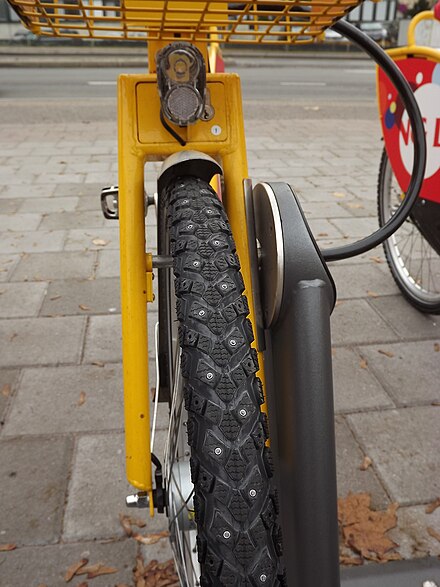
Stay safe
Cars
When biking along cars, especially where there are few bikers, it is essential that you are easily seen. Wear bright coloured clothes. There are rear reflectors sticking out on the side of the traffic (left in most countries) to remind drivers to keep the distance. From dusk to dawn you should have good head and rear lights and reflectors also on the spokes and pedals.
Theft
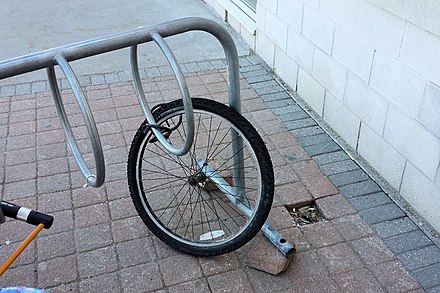 Bike thefts are common in many countries. Although locks cannot prevent theft entirely, they can discourage it. This is especially true if there are easier targets nearby. A good lock is both hard to pick or decode, and hard to bypass with cutting tools or brute force. Fasten the lock in some stationary object when possible, and ideally through any quick release wheels as well. In some areas the bike should not be left outdoors overnight.
Bike thefts are common in many countries. Although locks cannot prevent theft entirely, they can discourage it. This is especially true if there are easier targets nearby. A good lock is both hard to pick or decode, and hard to bypass with cutting tools or brute force. Fasten the lock in some stationary object when possible, and ideally through any quick release wheels as well. In some areas the bike should not be left outdoors overnight.
Some "Smart Bikes" have integral tracking devices and regular bikes can be fitted with aftermarket ones. These depend on their own battery supply, data connection, and ability to remain inconspicuous after being stolen, and if any one of them fails, you'll be out your bike. Some are capable of sending alerts to your phone if they are being moved while locked, so if you are nearby you may have time to catch a thief in the act. Remember that your ability to get your stolen bike back is only as good as the desire of the local police to get it. Inside the European Union unfortunately there is not yet a cross-border tracking system for stolen bikes or their frame register numbers even though the borders are largely open to the free flow of goods capital and people.
Mountainbikes and racing bikes typically have quick release valves, and other loose equipment, which make them easier to steal. If you use that kind of bike for urban cycling, it would be wise to refit it with traditional nuts and bolts, and to avoid making an expensive bike your daily driver.